BO1BLAW204 Business Law: Analyzing Negligence and Pet Owner Liability
VerifiedAdded on 2023/06/04
|11
|2670
|407
Case Study
AI Summary
This case study analyzes whether Susan is liable for economic loss and psychiatric injury suffered by Cliff and Mary due to an incident involving her Bengal Tigress, Benji. The analysis applies principles of tort law, specifically negligence, examining the existence of a duty of care, breach of that duty, and causation. It considers relevant case law such as Donoghue v Stevenson and Caparo Industries PLC v Dickman to determine if Susan owed a duty of care to her neighbors and whether she breached that duty. The study also evaluates foreseeability of risk and remoteness of damages, concluding that Susan acted reasonably and the damages were not a direct result of her negligence, potentially allowing her to utilize defenses such as contributory negligence. Desklib provides access to similar solved assignments and past papers for students.
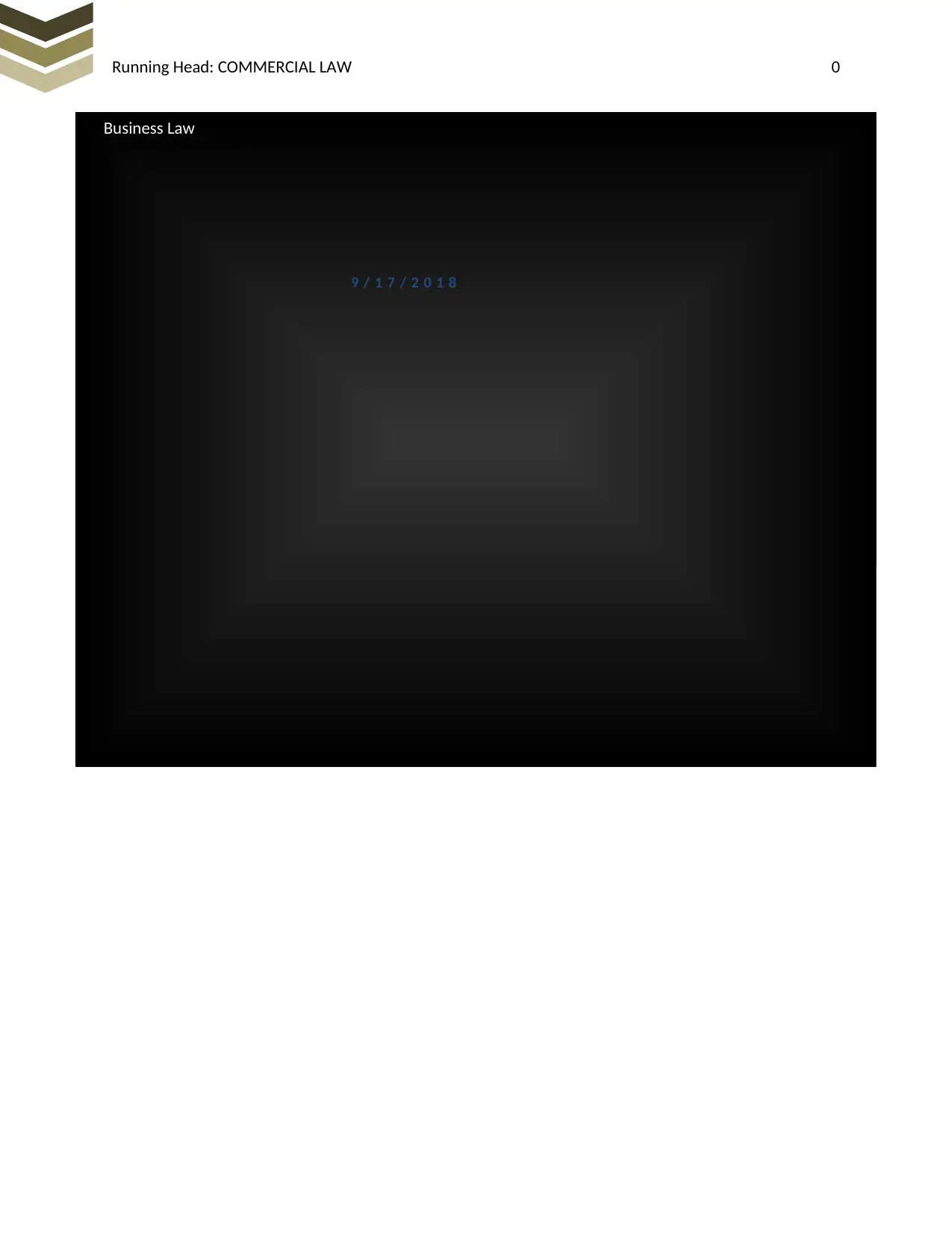
Business Law
Running Head: COMMERCIAL LAW 0
9 / 1 7 / 2 0 1 8
Student’s Name
Running Head: COMMERCIAL LAW 0
9 / 1 7 / 2 0 1 8
Student’s Name
Paraphrase This Document
Need a fresh take? Get an instant paraphrase of this document with our AI Paraphraser
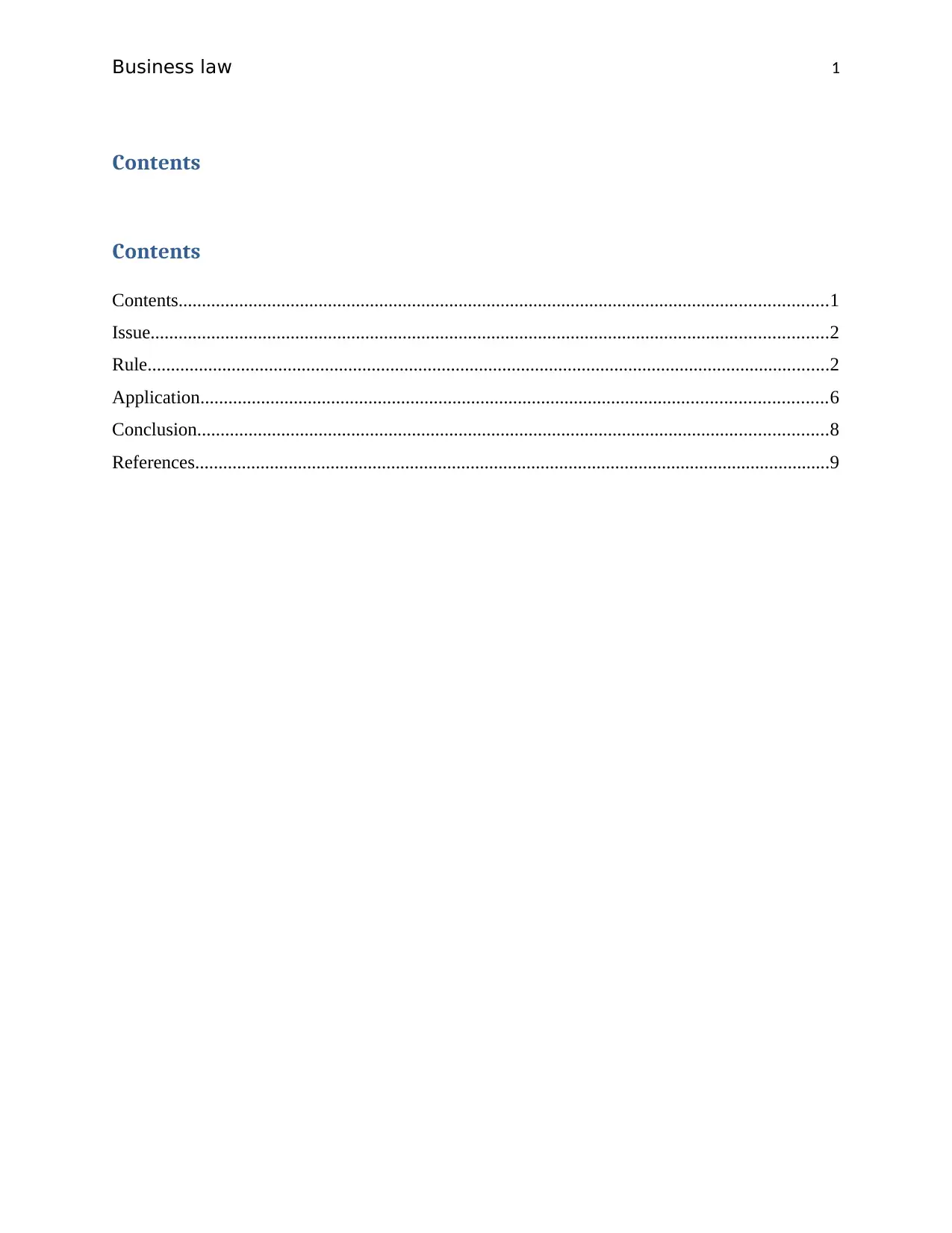
Business law 1
Contents
Contents
Contents...........................................................................................................................................1
Issue.................................................................................................................................................2
Rule..................................................................................................................................................2
Application......................................................................................................................................6
Conclusion.......................................................................................................................................8
References........................................................................................................................................9
Contents
Contents
Contents...........................................................................................................................................1
Issue.................................................................................................................................................2
Rule..................................................................................................................................................2
Application......................................................................................................................................6
Conclusion.......................................................................................................................................8
References........................................................................................................................................9
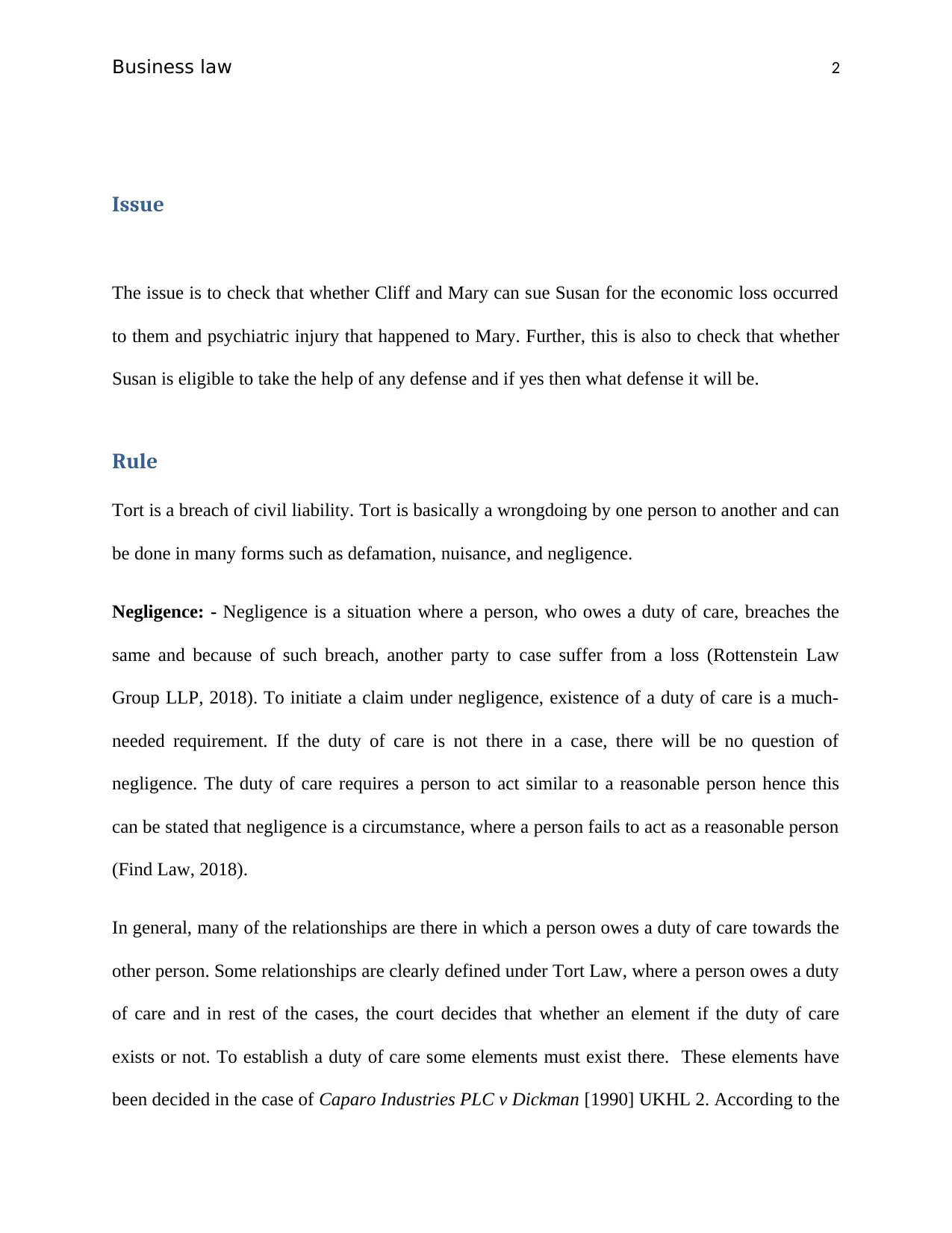
Business law 2
Issue
The issue is to check that whether Cliff and Mary can sue Susan for the economic loss occurred
to them and psychiatric injury that happened to Mary. Further, this is also to check that whether
Susan is eligible to take the help of any defense and if yes then what defense it will be.
Rule
Tort is a breach of civil liability. Tort is basically a wrongdoing by one person to another and can
be done in many forms such as defamation, nuisance, and negligence.
Negligence: - Negligence is a situation where a person, who owes a duty of care, breaches the
same and because of such breach, another party to case suffer from a loss (Rottenstein Law
Group LLP, 2018). To initiate a claim under negligence, existence of a duty of care is a much-
needed requirement. If the duty of care is not there in a case, there will be no question of
negligence. The duty of care requires a person to act similar to a reasonable person hence this
can be stated that negligence is a circumstance, where a person fails to act as a reasonable person
(Find Law, 2018).
In general, many of the relationships are there in which a person owes a duty of care towards the
other person. Some relationships are clearly defined under Tort Law, where a person owes a duty
of care and in rest of the cases, the court decides that whether an element if the duty of care
exists or not. To establish a duty of care some elements must exist there. These elements have
been decided in the case of Caparo Industries PLC v Dickman [1990] UKHL 2. According to the
Issue
The issue is to check that whether Cliff and Mary can sue Susan for the economic loss occurred
to them and psychiatric injury that happened to Mary. Further, this is also to check that whether
Susan is eligible to take the help of any defense and if yes then what defense it will be.
Rule
Tort is a breach of civil liability. Tort is basically a wrongdoing by one person to another and can
be done in many forms such as defamation, nuisance, and negligence.
Negligence: - Negligence is a situation where a person, who owes a duty of care, breaches the
same and because of such breach, another party to case suffer from a loss (Rottenstein Law
Group LLP, 2018). To initiate a claim under negligence, existence of a duty of care is a much-
needed requirement. If the duty of care is not there in a case, there will be no question of
negligence. The duty of care requires a person to act similar to a reasonable person hence this
can be stated that negligence is a circumstance, where a person fails to act as a reasonable person
(Find Law, 2018).
In general, many of the relationships are there in which a person owes a duty of care towards the
other person. Some relationships are clearly defined under Tort Law, where a person owes a duty
of care and in rest of the cases, the court decides that whether an element if the duty of care
exists or not. To establish a duty of care some elements must exist there. These elements have
been decided in the case of Caparo Industries PLC v Dickman [1990] UKHL 2. According to the
⊘ This is a preview!⊘
Do you want full access?
Subscribe today to unlock all pages.

Trusted by 1+ million students worldwide
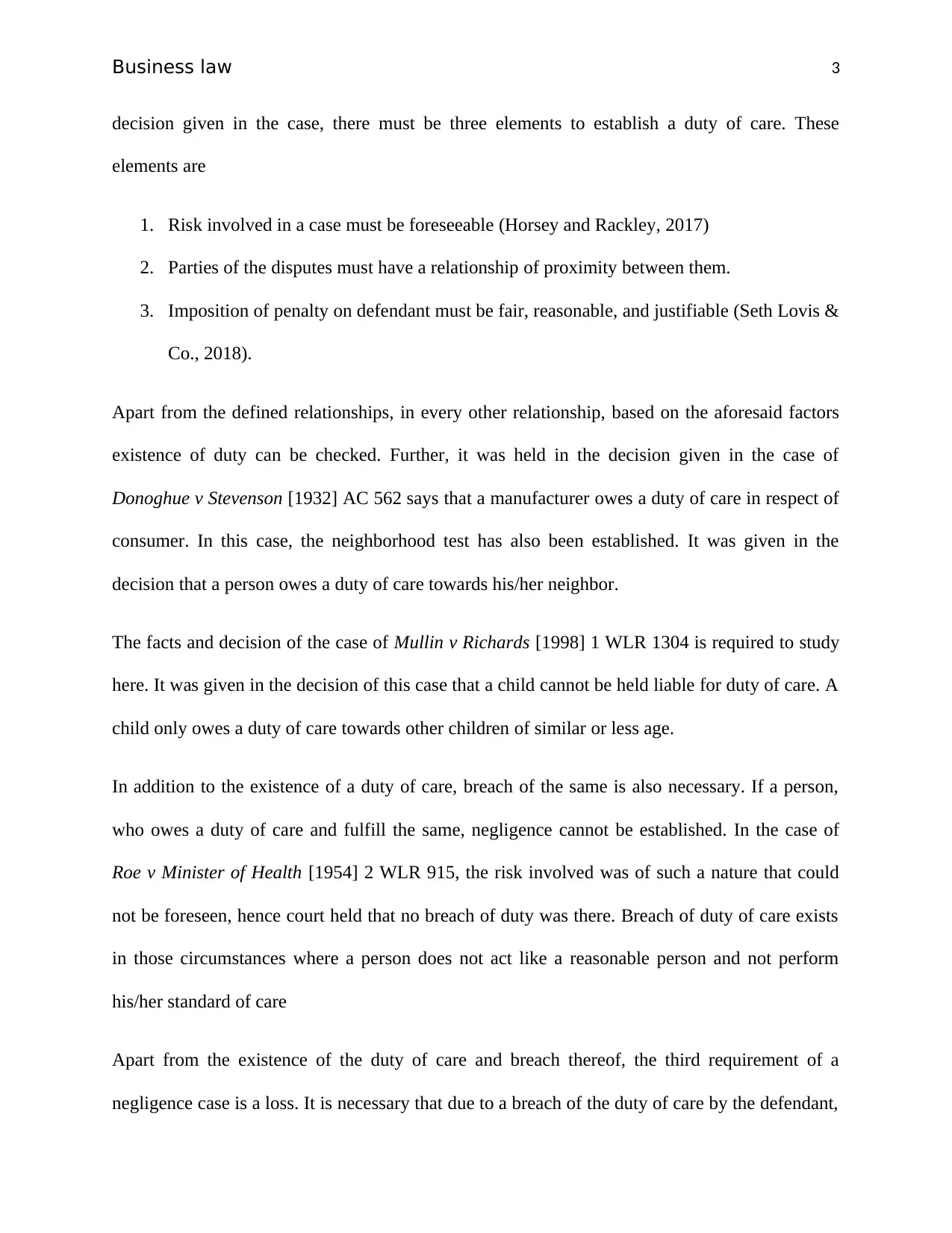
Business law 3
decision given in the case, there must be three elements to establish a duty of care. These
elements are
1. Risk involved in a case must be foreseeable (Horsey and Rackley, 2017)
2. Parties of the disputes must have a relationship of proximity between them.
3. Imposition of penalty on defendant must be fair, reasonable, and justifiable (Seth Lovis &
Co., 2018).
Apart from the defined relationships, in every other relationship, based on the aforesaid factors
existence of duty can be checked. Further, it was held in the decision given in the case of
Donoghue v Stevenson [1932] AC 562 says that a manufacturer owes a duty of care in respect of
consumer. In this case, the neighborhood test has also been established. It was given in the
decision that a person owes a duty of care towards his/her neighbor.
The facts and decision of the case of Mullin v Richards [1998] 1 WLR 1304 is required to study
here. It was given in the decision of this case that a child cannot be held liable for duty of care. A
child only owes a duty of care towards other children of similar or less age.
In addition to the existence of a duty of care, breach of the same is also necessary. If a person,
who owes a duty of care and fulfill the same, negligence cannot be established. In the case of
Roe v Minister of Health [1954] 2 WLR 915, the risk involved was of such a nature that could
not be foreseen, hence court held that no breach of duty was there. Breach of duty of care exists
in those circumstances where a person does not act like a reasonable person and not perform
his/her standard of care
Apart from the existence of the duty of care and breach thereof, the third requirement of a
negligence case is a loss. It is necessary that due to a breach of the duty of care by the defendant,
decision given in the case, there must be three elements to establish a duty of care. These
elements are
1. Risk involved in a case must be foreseeable (Horsey and Rackley, 2017)
2. Parties of the disputes must have a relationship of proximity between them.
3. Imposition of penalty on defendant must be fair, reasonable, and justifiable (Seth Lovis &
Co., 2018).
Apart from the defined relationships, in every other relationship, based on the aforesaid factors
existence of duty can be checked. Further, it was held in the decision given in the case of
Donoghue v Stevenson [1932] AC 562 says that a manufacturer owes a duty of care in respect of
consumer. In this case, the neighborhood test has also been established. It was given in the
decision that a person owes a duty of care towards his/her neighbor.
The facts and decision of the case of Mullin v Richards [1998] 1 WLR 1304 is required to study
here. It was given in the decision of this case that a child cannot be held liable for duty of care. A
child only owes a duty of care towards other children of similar or less age.
In addition to the existence of a duty of care, breach of the same is also necessary. If a person,
who owes a duty of care and fulfill the same, negligence cannot be established. In the case of
Roe v Minister of Health [1954] 2 WLR 915, the risk involved was of such a nature that could
not be foreseen, hence court held that no breach of duty was there. Breach of duty of care exists
in those circumstances where a person does not act like a reasonable person and not perform
his/her standard of care
Apart from the existence of the duty of care and breach thereof, the third requirement of a
negligence case is a loss. It is necessary that due to a breach of the duty of care by the defendant,
Paraphrase This Document
Need a fresh take? Get an instant paraphrase of this document with our AI Paraphraser
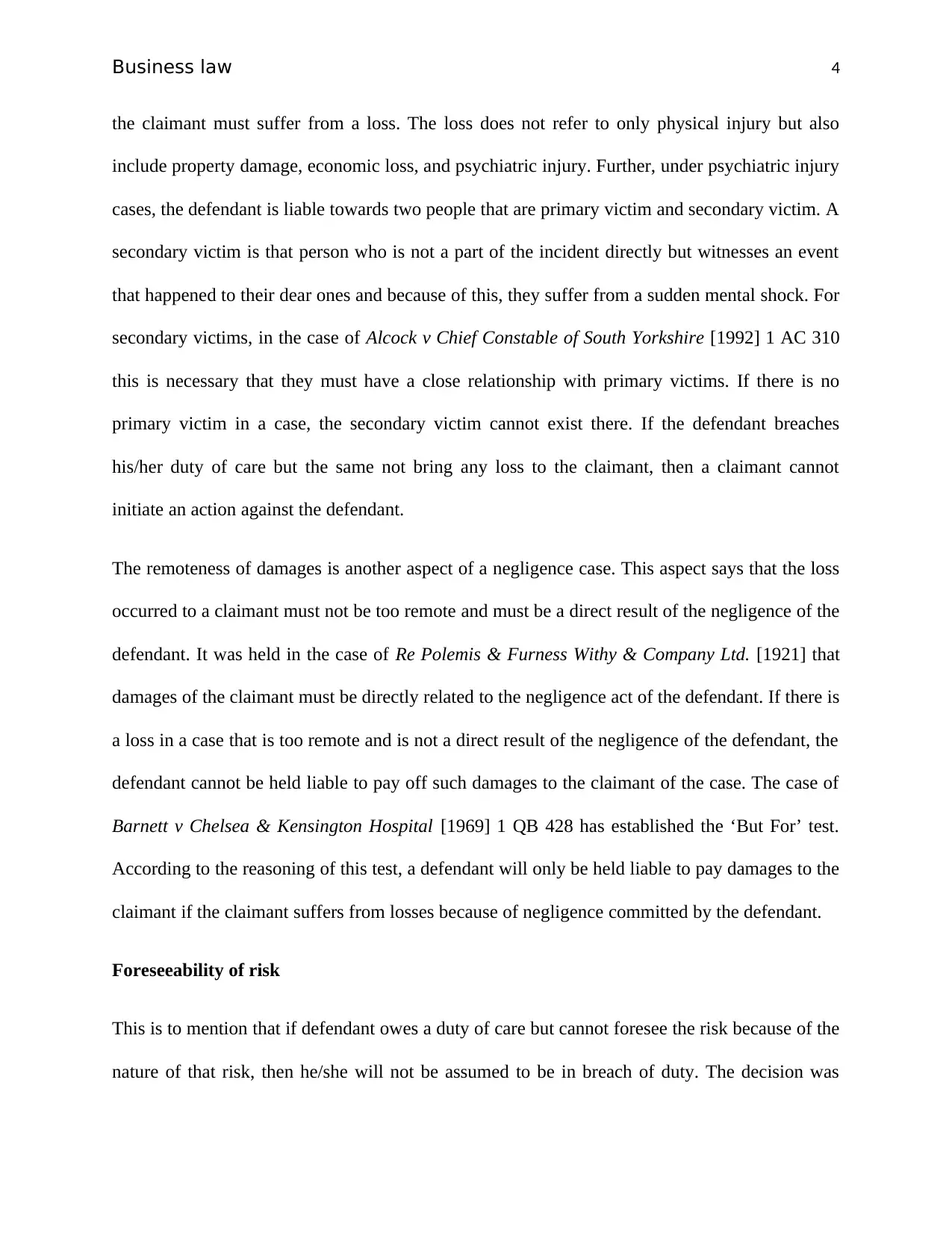
Business law 4
the claimant must suffer from a loss. The loss does not refer to only physical injury but also
include property damage, economic loss, and psychiatric injury. Further, under psychiatric injury
cases, the defendant is liable towards two people that are primary victim and secondary victim. A
secondary victim is that person who is not a part of the incident directly but witnesses an event
that happened to their dear ones and because of this, they suffer from a sudden mental shock. For
secondary victims, in the case of Alcock v Chief Constable of South Yorkshire [1992] 1 AC 310
this is necessary that they must have a close relationship with primary victims. If there is no
primary victim in a case, the secondary victim cannot exist there. If the defendant breaches
his/her duty of care but the same not bring any loss to the claimant, then a claimant cannot
initiate an action against the defendant.
The remoteness of damages is another aspect of a negligence case. This aspect says that the loss
occurred to a claimant must not be too remote and must be a direct result of the negligence of the
defendant. It was held in the case of Re Polemis & Furness Withy & Company Ltd. [1921] that
damages of the claimant must be directly related to the negligence act of the defendant. If there is
a loss in a case that is too remote and is not a direct result of the negligence of the defendant, the
defendant cannot be held liable to pay off such damages to the claimant of the case. The case of
Barnett v Chelsea & Kensington Hospital [1969] 1 QB 428 has established the ‘But For’ test.
According to the reasoning of this test, a defendant will only be held liable to pay damages to the
claimant if the claimant suffers from losses because of negligence committed by the defendant.
Foreseeability of risk
This is to mention that if defendant owes a duty of care but cannot foresee the risk because of the
nature of that risk, then he/she will not be assumed to be in breach of duty. The decision was
the claimant must suffer from a loss. The loss does not refer to only physical injury but also
include property damage, economic loss, and psychiatric injury. Further, under psychiatric injury
cases, the defendant is liable towards two people that are primary victim and secondary victim. A
secondary victim is that person who is not a part of the incident directly but witnesses an event
that happened to their dear ones and because of this, they suffer from a sudden mental shock. For
secondary victims, in the case of Alcock v Chief Constable of South Yorkshire [1992] 1 AC 310
this is necessary that they must have a close relationship with primary victims. If there is no
primary victim in a case, the secondary victim cannot exist there. If the defendant breaches
his/her duty of care but the same not bring any loss to the claimant, then a claimant cannot
initiate an action against the defendant.
The remoteness of damages is another aspect of a negligence case. This aspect says that the loss
occurred to a claimant must not be too remote and must be a direct result of the negligence of the
defendant. It was held in the case of Re Polemis & Furness Withy & Company Ltd. [1921] that
damages of the claimant must be directly related to the negligence act of the defendant. If there is
a loss in a case that is too remote and is not a direct result of the negligence of the defendant, the
defendant cannot be held liable to pay off such damages to the claimant of the case. The case of
Barnett v Chelsea & Kensington Hospital [1969] 1 QB 428 has established the ‘But For’ test.
According to the reasoning of this test, a defendant will only be held liable to pay damages to the
claimant if the claimant suffers from losses because of negligence committed by the defendant.
Foreseeability of risk
This is to mention that if defendant owes a duty of care but cannot foresee the risk because of the
nature of that risk, then he/she will not be assumed to be in breach of duty. The decision was
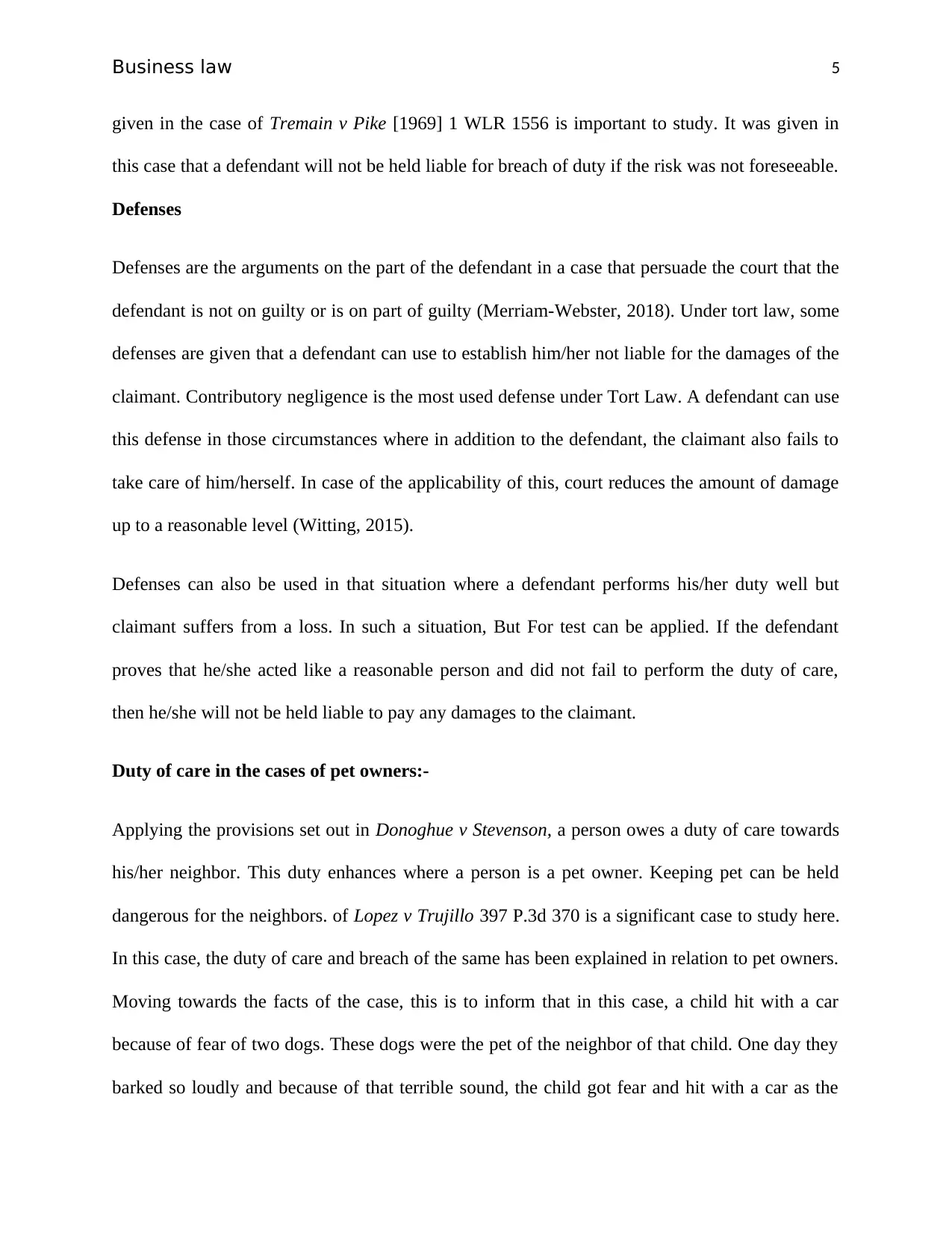
Business law 5
given in the case of Tremain v Pike [1969] 1 WLR 1556 is important to study. It was given in
this case that a defendant will not be held liable for breach of duty if the risk was not foreseeable.
Defenses
Defenses are the arguments on the part of the defendant in a case that persuade the court that the
defendant is not on guilty or is on part of guilty (Merriam-Webster, 2018). Under tort law, some
defenses are given that a defendant can use to establish him/her not liable for the damages of the
claimant. Contributory negligence is the most used defense under Tort Law. A defendant can use
this defense in those circumstances where in addition to the defendant, the claimant also fails to
take care of him/herself. In case of the applicability of this, court reduces the amount of damage
up to a reasonable level (Witting, 2015).
Defenses can also be used in that situation where a defendant performs his/her duty well but
claimant suffers from a loss. In such a situation, But For test can be applied. If the defendant
proves that he/she acted like a reasonable person and did not fail to perform the duty of care,
then he/she will not be held liable to pay any damages to the claimant.
Duty of care in the cases of pet owners:-
Applying the provisions set out in Donoghue v Stevenson, a person owes a duty of care towards
his/her neighbor. This duty enhances where a person is a pet owner. Keeping pet can be held
dangerous for the neighbors. of Lopez v Trujillo 397 P.3d 370 is a significant case to study here.
In this case, the duty of care and breach of the same has been explained in relation to pet owners.
Moving towards the facts of the case, this is to inform that in this case, a child hit with a car
because of fear of two dogs. These dogs were the pet of the neighbor of that child. One day they
barked so loudly and because of that terrible sound, the child got fear and hit with a car as the
given in the case of Tremain v Pike [1969] 1 WLR 1556 is important to study. It was given in
this case that a defendant will not be held liable for breach of duty if the risk was not foreseeable.
Defenses
Defenses are the arguments on the part of the defendant in a case that persuade the court that the
defendant is not on guilty or is on part of guilty (Merriam-Webster, 2018). Under tort law, some
defenses are given that a defendant can use to establish him/her not liable for the damages of the
claimant. Contributory negligence is the most used defense under Tort Law. A defendant can use
this defense in those circumstances where in addition to the defendant, the claimant also fails to
take care of him/herself. In case of the applicability of this, court reduces the amount of damage
up to a reasonable level (Witting, 2015).
Defenses can also be used in that situation where a defendant performs his/her duty well but
claimant suffers from a loss. In such a situation, But For test can be applied. If the defendant
proves that he/she acted like a reasonable person and did not fail to perform the duty of care,
then he/she will not be held liable to pay any damages to the claimant.
Duty of care in the cases of pet owners:-
Applying the provisions set out in Donoghue v Stevenson, a person owes a duty of care towards
his/her neighbor. This duty enhances where a person is a pet owner. Keeping pet can be held
dangerous for the neighbors. of Lopez v Trujillo 397 P.3d 370 is a significant case to study here.
In this case, the duty of care and breach of the same has been explained in relation to pet owners.
Moving towards the facts of the case, this is to inform that in this case, a child hit with a car
because of fear of two dogs. These dogs were the pet of the neighbor of that child. One day they
barked so loudly and because of that terrible sound, the child got fear and hit with a car as the
⊘ This is a preview!⊘
Do you want full access?
Subscribe today to unlock all pages.

Trusted by 1+ million students worldwide
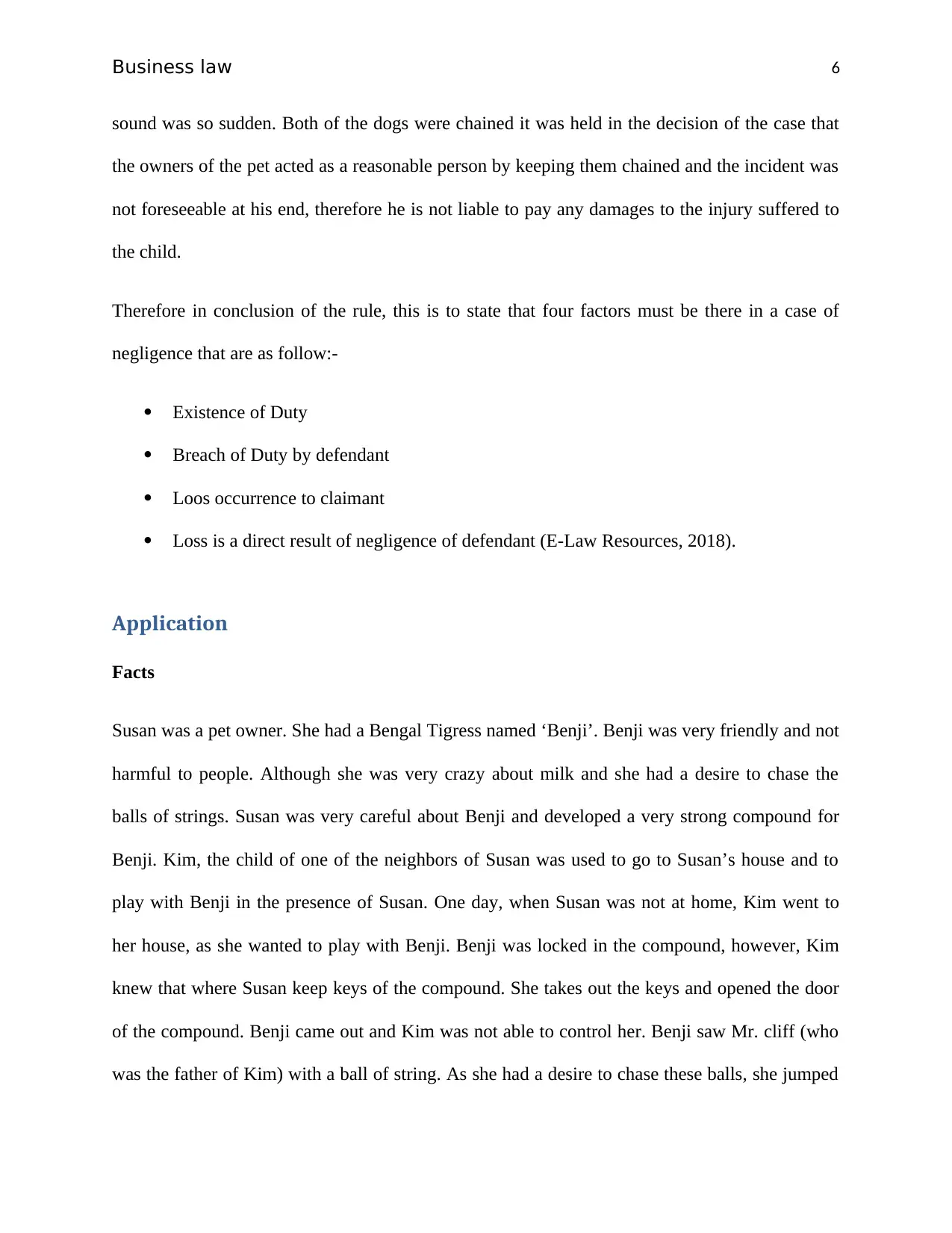
Business law 6
sound was so sudden. Both of the dogs were chained it was held in the decision of the case that
the owners of the pet acted as a reasonable person by keeping them chained and the incident was
not foreseeable at his end, therefore he is not liable to pay any damages to the injury suffered to
the child.
Therefore in conclusion of the rule, this is to state that four factors must be there in a case of
negligence that are as follow:-
Existence of Duty
Breach of Duty by defendant
Loos occurrence to claimant
Loss is a direct result of negligence of defendant (E-Law Resources, 2018).
Application
Facts
Susan was a pet owner. She had a Bengal Tigress named ‘Benji’. Benji was very friendly and not
harmful to people. Although she was very crazy about milk and she had a desire to chase the
balls of strings. Susan was very careful about Benji and developed a very strong compound for
Benji. Kim, the child of one of the neighbors of Susan was used to go to Susan’s house and to
play with Benji in the presence of Susan. One day, when Susan was not at home, Kim went to
her house, as she wanted to play with Benji. Benji was locked in the compound, however, Kim
knew that where Susan keep keys of the compound. She takes out the keys and opened the door
of the compound. Benji came out and Kim was not able to control her. Benji saw Mr. cliff (who
was the father of Kim) with a ball of string. As she had a desire to chase these balls, she jumped
sound was so sudden. Both of the dogs were chained it was held in the decision of the case that
the owners of the pet acted as a reasonable person by keeping them chained and the incident was
not foreseeable at his end, therefore he is not liable to pay any damages to the injury suffered to
the child.
Therefore in conclusion of the rule, this is to state that four factors must be there in a case of
negligence that are as follow:-
Existence of Duty
Breach of Duty by defendant
Loos occurrence to claimant
Loss is a direct result of negligence of defendant (E-Law Resources, 2018).
Application
Facts
Susan was a pet owner. She had a Bengal Tigress named ‘Benji’. Benji was very friendly and not
harmful to people. Although she was very crazy about milk and she had a desire to chase the
balls of strings. Susan was very careful about Benji and developed a very strong compound for
Benji. Kim, the child of one of the neighbors of Susan was used to go to Susan’s house and to
play with Benji in the presence of Susan. One day, when Susan was not at home, Kim went to
her house, as she wanted to play with Benji. Benji was locked in the compound, however, Kim
knew that where Susan keep keys of the compound. She takes out the keys and opened the door
of the compound. Benji came out and Kim was not able to control her. Benji saw Mr. cliff (who
was the father of Kim) with a ball of string. As she had a desire to chase these balls, she jumped
Paraphrase This Document
Need a fresh take? Get an instant paraphrase of this document with our AI Paraphraser
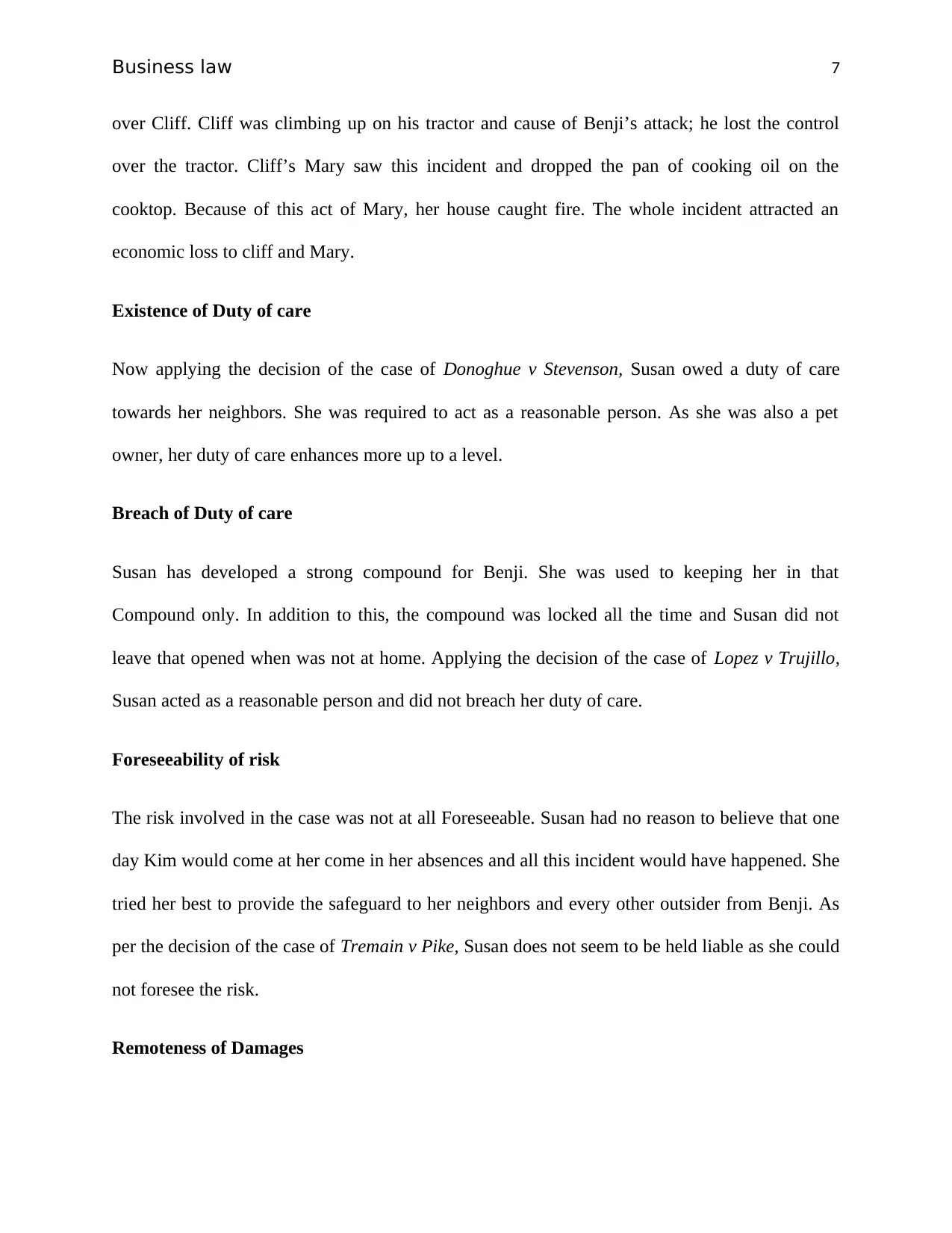
Business law 7
over Cliff. Cliff was climbing up on his tractor and cause of Benji’s attack; he lost the control
over the tractor. Cliff’s Mary saw this incident and dropped the pan of cooking oil on the
cooktop. Because of this act of Mary, her house caught fire. The whole incident attracted an
economic loss to cliff and Mary.
Existence of Duty of care
Now applying the decision of the case of Donoghue v Stevenson, Susan owed a duty of care
towards her neighbors. She was required to act as a reasonable person. As she was also a pet
owner, her duty of care enhances more up to a level.
Breach of Duty of care
Susan has developed a strong compound for Benji. She was used to keeping her in that
Compound only. In addition to this, the compound was locked all the time and Susan did not
leave that opened when was not at home. Applying the decision of the case of Lopez v Trujillo,
Susan acted as a reasonable person and did not breach her duty of care.
Foreseeability of risk
The risk involved in the case was not at all Foreseeable. Susan had no reason to believe that one
day Kim would come at her come in her absences and all this incident would have happened. She
tried her best to provide the safeguard to her neighbors and every other outsider from Benji. As
per the decision of the case of Tremain v Pike, Susan does not seem to be held liable as she could
not foresee the risk.
Remoteness of Damages
over Cliff. Cliff was climbing up on his tractor and cause of Benji’s attack; he lost the control
over the tractor. Cliff’s Mary saw this incident and dropped the pan of cooking oil on the
cooktop. Because of this act of Mary, her house caught fire. The whole incident attracted an
economic loss to cliff and Mary.
Existence of Duty of care
Now applying the decision of the case of Donoghue v Stevenson, Susan owed a duty of care
towards her neighbors. She was required to act as a reasonable person. As she was also a pet
owner, her duty of care enhances more up to a level.
Breach of Duty of care
Susan has developed a strong compound for Benji. She was used to keeping her in that
Compound only. In addition to this, the compound was locked all the time and Susan did not
leave that opened when was not at home. Applying the decision of the case of Lopez v Trujillo,
Susan acted as a reasonable person and did not breach her duty of care.
Foreseeability of risk
The risk involved in the case was not at all Foreseeable. Susan had no reason to believe that one
day Kim would come at her come in her absences and all this incident would have happened. She
tried her best to provide the safeguard to her neighbors and every other outsider from Benji. As
per the decision of the case of Tremain v Pike, Susan does not seem to be held liable as she could
not foresee the risk.
Remoteness of Damages
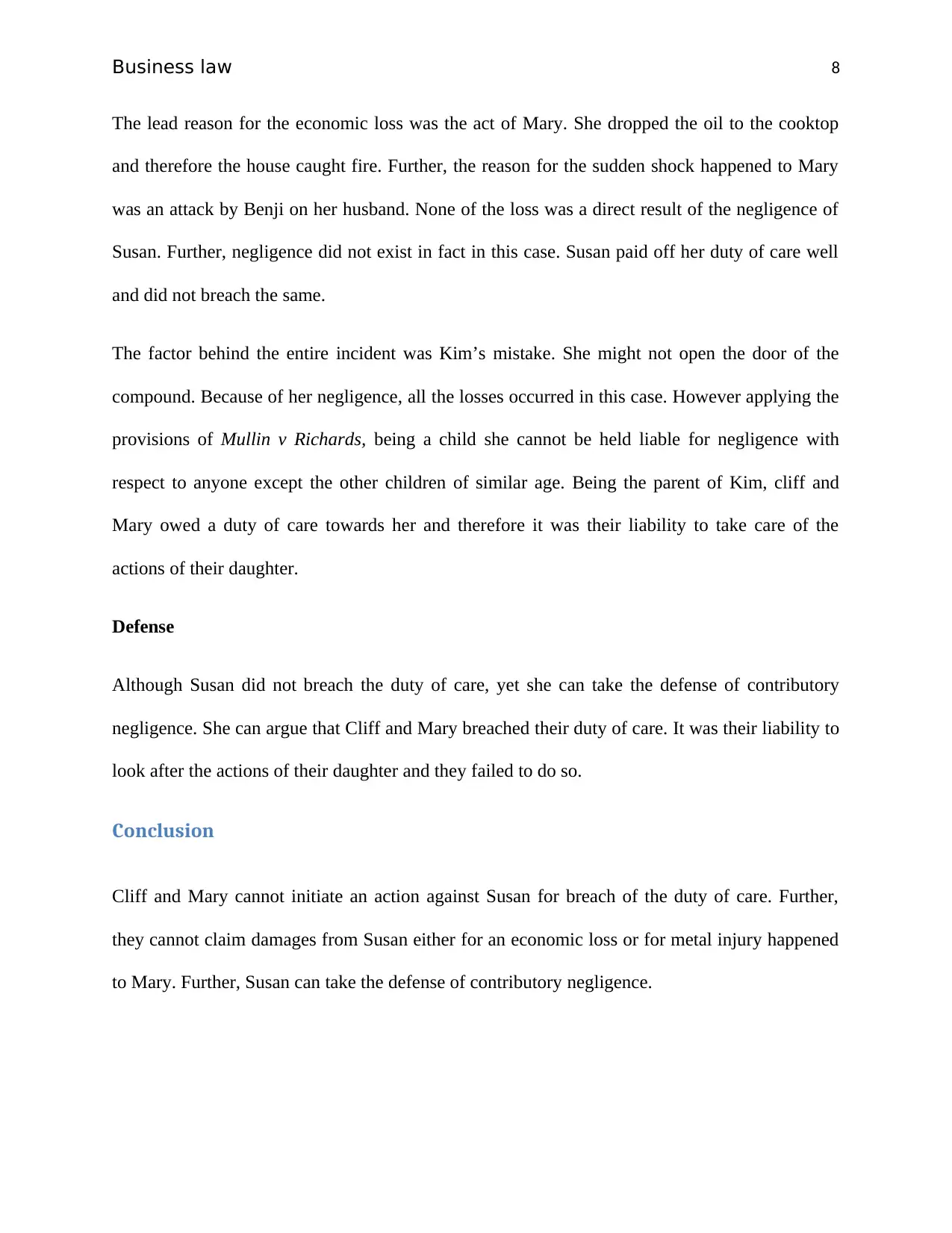
Business law 8
The lead reason for the economic loss was the act of Mary. She dropped the oil to the cooktop
and therefore the house caught fire. Further, the reason for the sudden shock happened to Mary
was an attack by Benji on her husband. None of the loss was a direct result of the negligence of
Susan. Further, negligence did not exist in fact in this case. Susan paid off her duty of care well
and did not breach the same.
The factor behind the entire incident was Kim’s mistake. She might not open the door of the
compound. Because of her negligence, all the losses occurred in this case. However applying the
provisions of Mullin v Richards, being a child she cannot be held liable for negligence with
respect to anyone except the other children of similar age. Being the parent of Kim, cliff and
Mary owed a duty of care towards her and therefore it was their liability to take care of the
actions of their daughter.
Defense
Although Susan did not breach the duty of care, yet she can take the defense of contributory
negligence. She can argue that Cliff and Mary breached their duty of care. It was their liability to
look after the actions of their daughter and they failed to do so.
Conclusion
Cliff and Mary cannot initiate an action against Susan for breach of the duty of care. Further,
they cannot claim damages from Susan either for an economic loss or for metal injury happened
to Mary. Further, Susan can take the defense of contributory negligence.
The lead reason for the economic loss was the act of Mary. She dropped the oil to the cooktop
and therefore the house caught fire. Further, the reason for the sudden shock happened to Mary
was an attack by Benji on her husband. None of the loss was a direct result of the negligence of
Susan. Further, negligence did not exist in fact in this case. Susan paid off her duty of care well
and did not breach the same.
The factor behind the entire incident was Kim’s mistake. She might not open the door of the
compound. Because of her negligence, all the losses occurred in this case. However applying the
provisions of Mullin v Richards, being a child she cannot be held liable for negligence with
respect to anyone except the other children of similar age. Being the parent of Kim, cliff and
Mary owed a duty of care towards her and therefore it was their liability to take care of the
actions of their daughter.
Defense
Although Susan did not breach the duty of care, yet she can take the defense of contributory
negligence. She can argue that Cliff and Mary breached their duty of care. It was their liability to
look after the actions of their daughter and they failed to do so.
Conclusion
Cliff and Mary cannot initiate an action against Susan for breach of the duty of care. Further,
they cannot claim damages from Susan either for an economic loss or for metal injury happened
to Mary. Further, Susan can take the defense of contributory negligence.
⊘ This is a preview!⊘
Do you want full access?
Subscribe today to unlock all pages.

Trusted by 1+ million students worldwide
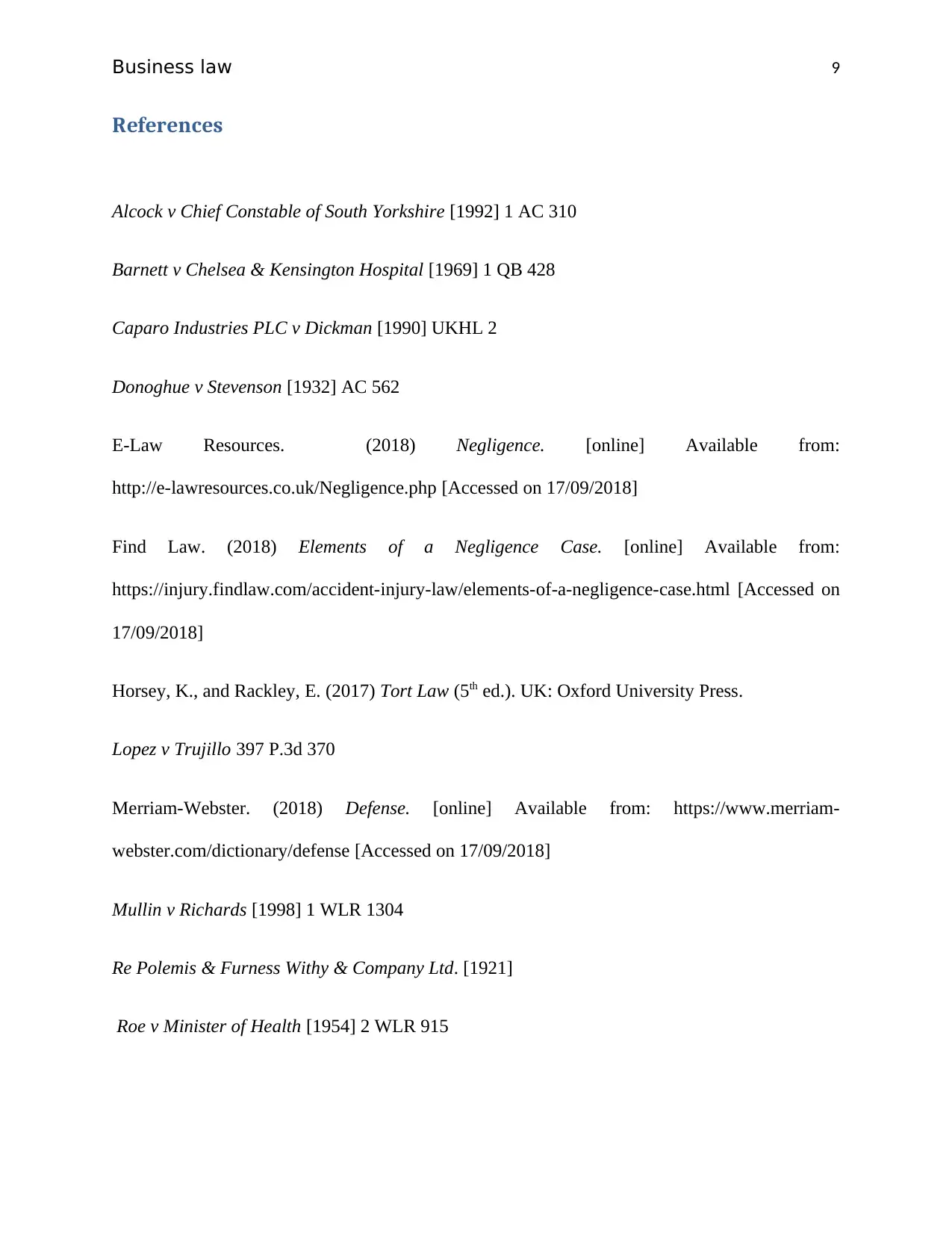
Business law 9
References
Alcock v Chief Constable of South Yorkshire [1992] 1 AC 310
Barnett v Chelsea & Kensington Hospital [1969] 1 QB 428
Caparo Industries PLC v Dickman [1990] UKHL 2
Donoghue v Stevenson [1932] AC 562
E-Law Resources. (2018) Negligence. [online] Available from:
http://e-lawresources.co.uk/Negligence.php [Accessed on 17/09/2018]
Find Law. (2018) Elements of a Negligence Case. [online] Available from:
https://injury.findlaw.com/accident-injury-law/elements-of-a-negligence-case.html [Accessed on
17/09/2018]
Horsey, K., and Rackley, E. (2017) Tort Law (5th ed.). UK: Oxford University Press.
Lopez v Trujillo 397 P.3d 370
Merriam-Webster. (2018) Defense. [online] Available from: https://www.merriam-
webster.com/dictionary/defense [Accessed on 17/09/2018]
Mullin v Richards [1998] 1 WLR 1304
Re Polemis & Furness Withy & Company Ltd. [1921]
Roe v Minister of Health [1954] 2 WLR 915
References
Alcock v Chief Constable of South Yorkshire [1992] 1 AC 310
Barnett v Chelsea & Kensington Hospital [1969] 1 QB 428
Caparo Industries PLC v Dickman [1990] UKHL 2
Donoghue v Stevenson [1932] AC 562
E-Law Resources. (2018) Negligence. [online] Available from:
http://e-lawresources.co.uk/Negligence.php [Accessed on 17/09/2018]
Find Law. (2018) Elements of a Negligence Case. [online] Available from:
https://injury.findlaw.com/accident-injury-law/elements-of-a-negligence-case.html [Accessed on
17/09/2018]
Horsey, K., and Rackley, E. (2017) Tort Law (5th ed.). UK: Oxford University Press.
Lopez v Trujillo 397 P.3d 370
Merriam-Webster. (2018) Defense. [online] Available from: https://www.merriam-
webster.com/dictionary/defense [Accessed on 17/09/2018]
Mullin v Richards [1998] 1 WLR 1304
Re Polemis & Furness Withy & Company Ltd. [1921]
Roe v Minister of Health [1954] 2 WLR 915
Paraphrase This Document
Need a fresh take? Get an instant paraphrase of this document with our AI Paraphraser
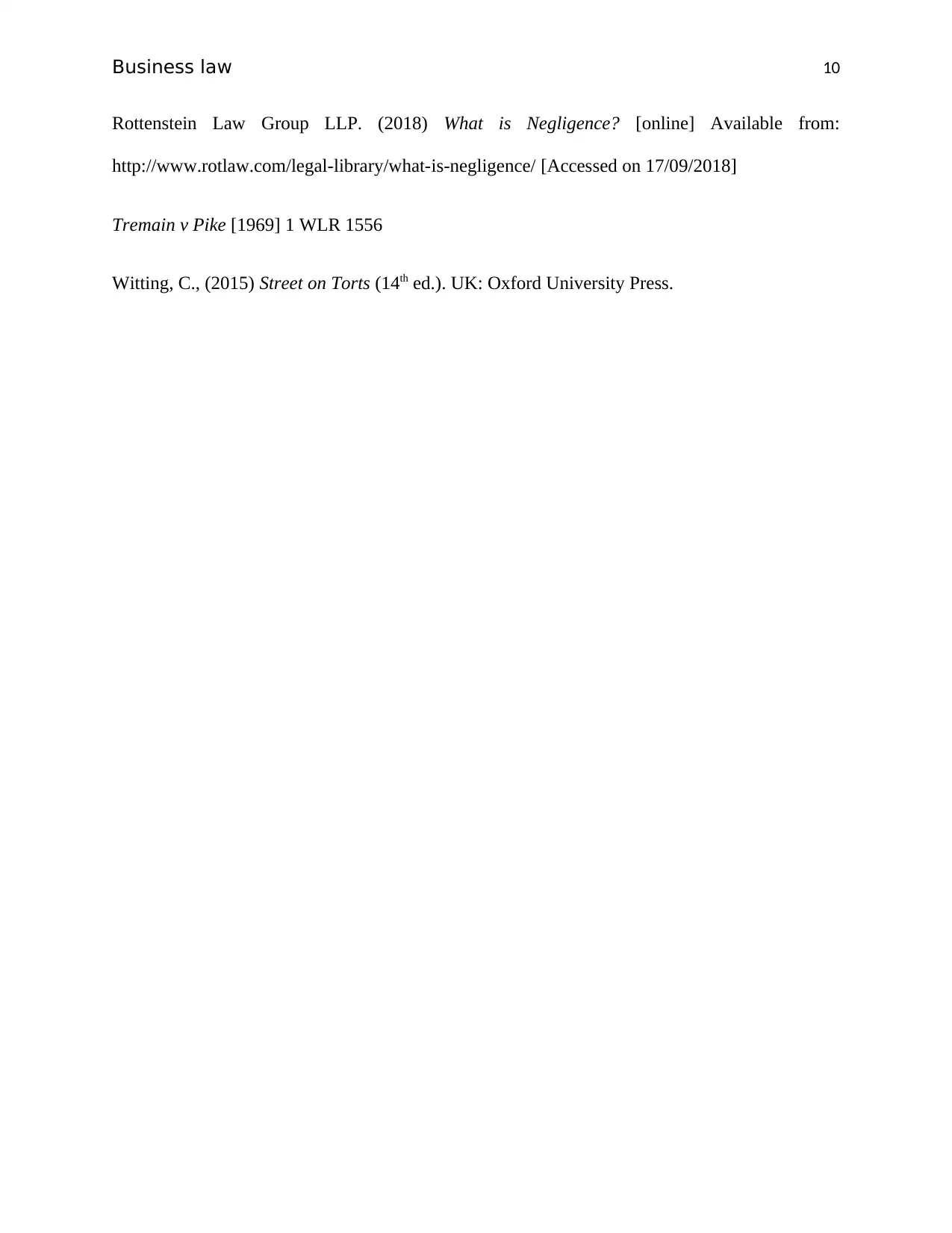
Business law 10
Rottenstein Law Group LLP. (2018) What is Negligence? [online] Available from:
http://www.rotlaw.com/legal-library/what-is-negligence/ [Accessed on 17/09/2018]
Tremain v Pike [1969] 1 WLR 1556
Witting, C., (2015) Street on Torts (14th ed.). UK: Oxford University Press.
Rottenstein Law Group LLP. (2018) What is Negligence? [online] Available from:
http://www.rotlaw.com/legal-library/what-is-negligence/ [Accessed on 17/09/2018]
Tremain v Pike [1969] 1 WLR 1556
Witting, C., (2015) Street on Torts (14th ed.). UK: Oxford University Press.
1 out of 11
Related Documents
Your All-in-One AI-Powered Toolkit for Academic Success.
+13062052269
info@desklib.com
Available 24*7 on WhatsApp / Email
![[object Object]](/_next/static/media/star-bottom.7253800d.svg)
Unlock your academic potential
Copyright © 2020–2025 A2Z Services. All Rights Reserved. Developed and managed by ZUCOL.




